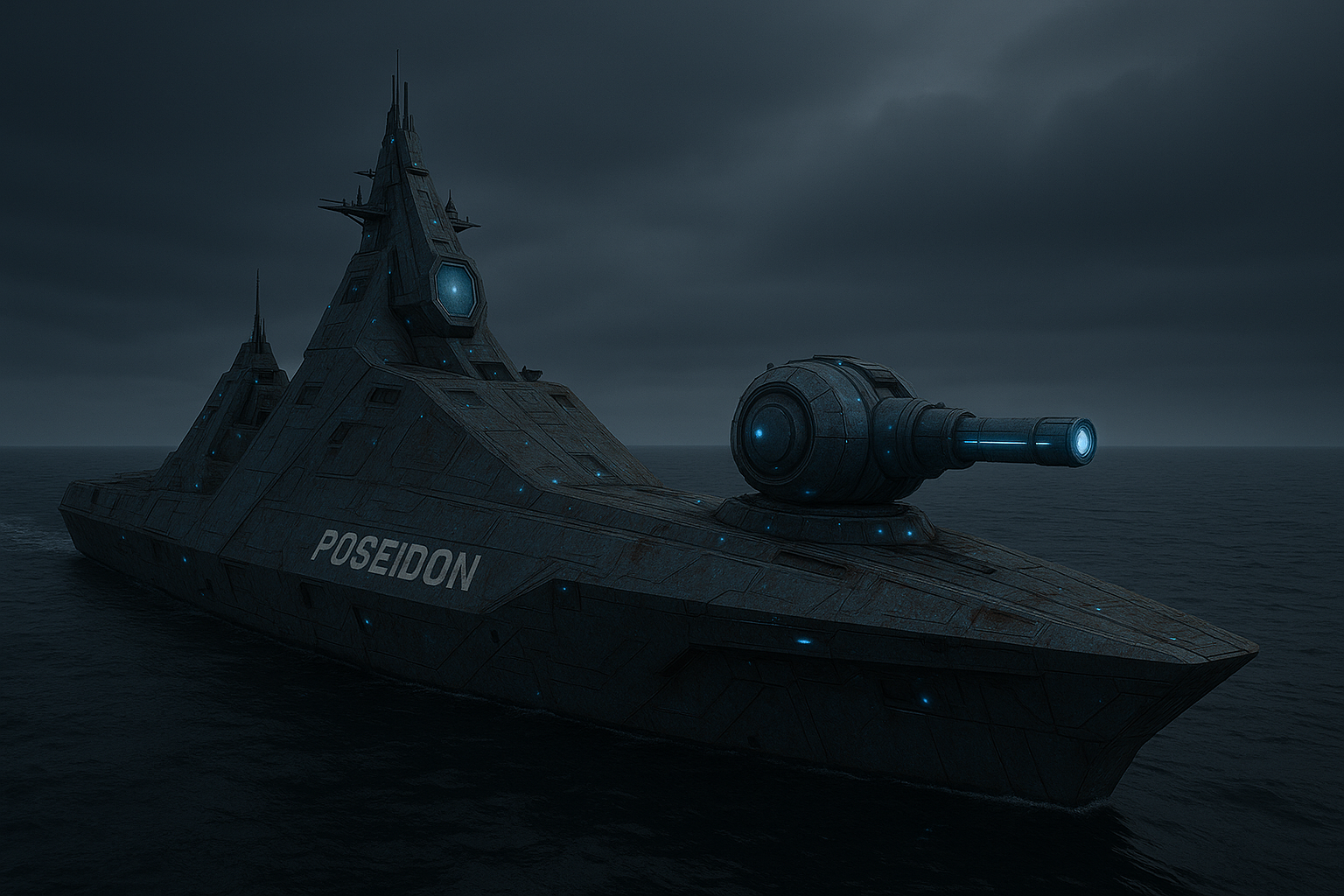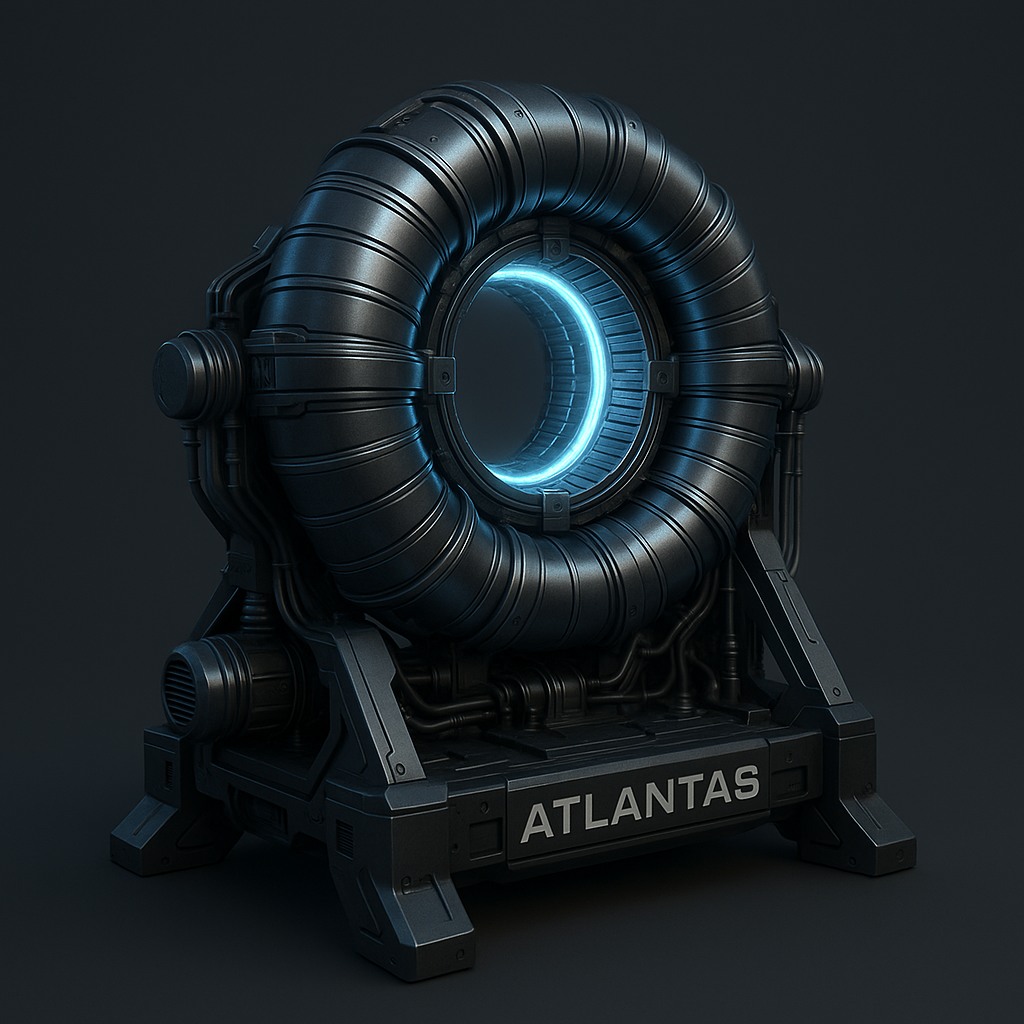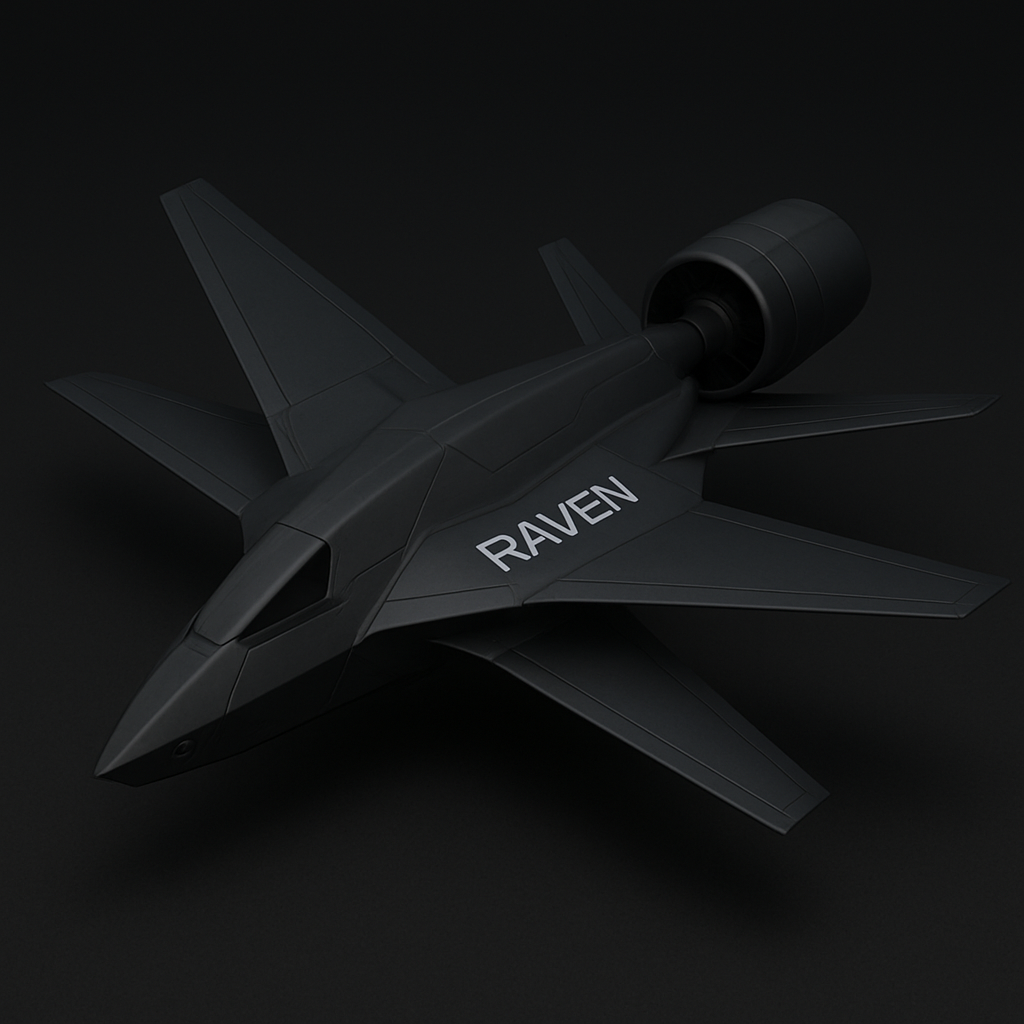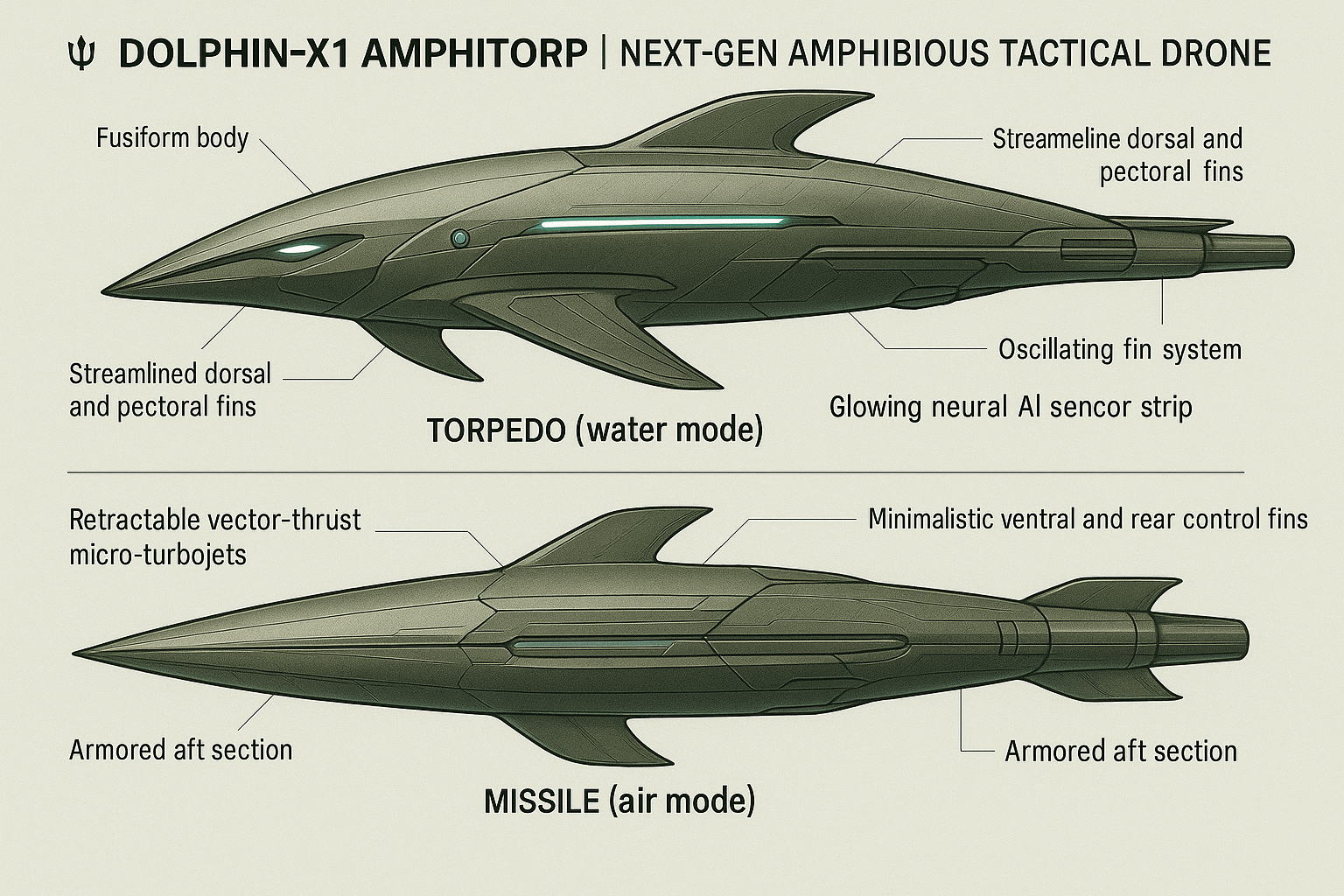
Prototypes
🔱 POSEIDON: Autonomous Quantum-Hydrokinetic Battleship
POSEIDON's main design innovation includes a revolutionary power and propulsion system which extends maritime capabilities. The vessel operates with a closed-cycle hydrogen combustion system which integrates modern electrolysis technology with advanced turbine systems to reach full energy autonomy. The multi-stage proton-exchange membrane electrolyzers utilize 92% efficiency to convert seawater into 4,000 liters of hydrogen and oxygen per hour. The compact fusion reactor produces 150 MW of continuous output to power this process. The extracted hydrogen powers modified aeroderivative gas turbines to produce 100,000 shaft horsepower through water vapor emissions only. The superconducting magnetic containment system operates at 20K (-253°C) to store hydrogen reserves with daily boil-off losses at less than 0.1% using clathrate hydrates. Marine propulsion has seen its most significant development through the quantum-enhanced hydrodynamic control system onboard the vessel. Using liquid helium to cool electromagnets into near-absolute zero allows the generation of precise Lorentz force fields that manipulate seawater at a molecular level. The system generates vortex ring propulsion which reaches 85% energy efficiency above conventional pump-jets by 20% while producing adjacent low-pressure regions that lower hydrodynamic drag by 40% during cruising speed. The technology enables the generation of standing wave barriers which extend 50 meters ahead of the hull to actively protect against both collisions and incoming threats.

The adaptive metamaterial hull from Poseidon functions through three graded layers that operate together. Battle-damage repair happens automatically because the exterior 10cm nanocomposite armor consists of boron nitride nanotubes embedded into shape-memory polymers. The active stealth mesh of tunable carbon metamaterials located beneath the surface allows the ship to dynamically change its radar cross-section between near-invisible 0.001 m² and deceptive 50 m² profiles. The hydrogel actuator layer at the core of the system completes the system by changing surface texture within 200 milliseconds to optimize hydrodynamic performance or achieve camouflage. A neuromorphic quantum computing core with 128-qubit processors performs 2.4 exaFLOPS real-time hydrodynamic simulations because they work together as a unit. The artificial nervous system operates every aspect of ship functions while merging predictive threat assessment with 98.7% accuracy across 1,200+ parameters for controlling 200 micro-drones through millimeter-wave mesh networking. The system leverages hundreds of sensors simultaneously to gather information which gives the AI full control over all operating domains. The mix of sheer weaponry power and exact projectile delivery systems make up armament systems. The magnetohydrodynamic railgun propels tungsten-aluminum composite projectiles to Mach 7.5 speeds at thirty rounds per minute when it delivers muzzle energy of 12MJ. The parametric array transducers generate 190dB low-frequency waves that extend over 18km distances while their frequency range spans from 5Hz bone-rattling waves to 200Hz hull-resonating waves. The defensive system incorporates adaptive optic 500kW fiber lasers which provide 98% probability of intercepting Mach 5 threats.
⭕ R&D prototype period: 15 years
⭕ Development cost: € 735B
⭕ Production cost: € 45B
🔱 Hephaestus-Class: Naval Plasma Cannon (DEW)
The Hephaestus-Class Naval Plasma Cannon operates aboard military vessels as a directed-energy weapon (DEW) system. The plasma cannon receives its main power from the vessel's fusion reactor which needs constant 275 MW energy input to operate, while plasma forms in a toroidal chamber at 28 million Kelvin under stabilization from 22 Tesla magnetic fields generated by cryogenic niobium-tin superconducting coils. A 120-meter electromagnetic rail drives the plasma towards 0.22c (66,000 km/s) velocity through segmented high-temperature superconducting coils then propels sixty milligrams of hydrogen plasma projectile at 1.8 GJ kinetic energy till it reaches its target, while thermal energy from target material fusion reaches 750 MJ. The fire control system connects to the combat AI system through tracking sensors which include an L-band radar with 1,200 km acquisition range, X-band terminal guidance radar and quantum-locked optical sensors that compensate for atmospheric distortion with millisecond-level latency to achieve a 0.25 meter circular error probable at 600 km range. The weapon mount uses six-axis gyroscopic dampeners for active stabilization, which enables compensation of Sea State 7 wave motion and reduces recoil forces beyond 175,000 N for each discharge.

The weapon utilizes two-stage cooling through helium cryogenic superconductors operating at 4.0 K and a lithium eutectic heat exchanger that dissipates 6.2 MW of waste heat to the ship's thermal management system per discharge. The Hephaestus-Class operates at a continuous fire rate of 12 rounds per minute yet can perform bursts at 25 rounds per minute for three minutes until needing seven minutes of cooldown time before reaching its maximum 60,000 full-power discharge limit at which point tungsten-carbide barrel erosion reaches 0.5 mm tolerances. Each shot requires 1.8 kilograms of deuterium-tritium fuel that the ship obtains from its cryogenic storage tanks, which hold up to 6,000 shots and can be replenished during underway replenishment operations. The combat capabilities of this weapon allow it to penetrate 5.2 meters of naval-grade HY-200 steel armor and 2.1 meters of advanced composite armor with reactive elements. Each round creates a 250-meter diameter fireball reaching 6,500 K that neutralizes unshielded targets in the zone. The weapon fires three rounds in four (4) seconds to penetrate energy shields that have a maximum dissipation rating of 35 GJ. Operational constraints of this system involve minimum 3.0 GW reactor power requirements for vessels and thermal management needs that force tactical pauses during continuous combat operations together with a 18% effective range reduction when operating in tropical conditions with high humidity because of atmospheric plasma scattering effects. The countermeasure resistance of this system consists of two elements: frequency-agile targeting systems that resist electronic jamming and plasma projectile coherence maintained through magnetic field stabilization.
⭕ R&D prototype period: 8 years
⭕ Development cost: € 12B
⭕ Production cost: € 350M + € 50M (naval integration)
⚜️ Cloud-N: Nanobot Fog
The Cloud-N represents an advanced nanotechnological weapon platform which enables fast and accurate destruction of enemy naval vessels together with coastal installations and orbital assets. The weapon system contains trillions of microscopic nanobots that measure between 10 and 100 nanometers in diameter which remain undetectable by radar sonar or optical systems. These diamondoid-carbon lattice nanobots show outstanding protection against electromagnetic pulses (EMP), extreme temperatures (2,000°C) and corrosive conditions, which allows them to operate in aerial and marine conditions. Cloud-N delivery systems operate with flexibility because they support deployment through various methods. The nanobots disperse through the air as an aerosolized fog through stealth drones or cruise missiles or specialized artillery shells at densities between 10⁶ to 10⁸ bots per cubic centimeter. The mist particles remain undetectable because they measure less than a wavelength and generate negligible electromagnetic signals. The nanobots deployed underwater come out of submarines or torpedoes as minimum-plume formations while traveling at ocean current rates between 0.1 to 1 meter per second to enable elliptical strikes on underwater targets. The nanobots feature two energy harvesting systems which use photovoltaic cells achieving 30–40% efficiency in bright conditions together with piezoelectric or triboelectric kinetic energy harvesting in dark or underwater conditions. The electrostatic and magnetic field control system enables swarm propulsion that moves at 1–10 centimeters per second in air and 0.1–1 centimeters per second underwater. A distributed artificial intelligence system drives the swarm operations through ultra-wideband femtosecond laser communication links which work at frequencies between 1 and 10 THz. The implementation of quantum-encrypted Identify Friend/Foe (IFF) protocols allows operators to select their targets while avoiding friendly forces.

The main attacking capability of this weapon enables nanobot manipulators to sever molecular bonds of Fe-C and Al-Si metal pairs and C-C and C-H polymer pairs through forces that reach piconewton scales. Under full swarm saturation a 10,000-ton warship would sustain structural damage in under 30 minutes because its steel components dissolve at a rate of 1 kilogram per second per 10¹² nanobots. The secondary attack methods of nanobots involve electronics infiltration by breaching circuitry through sub-micron gaps to trigger short circuits via 10–100 kV electrostatic discharges or direct nanowire bridging and fuel/explosive sabotage through catalytic reactions that decompose hydrocarbons or destabilize munitions. The nanobots possess an optional self-replication mode which enables them to extract local materials such as iron, carbon, silicon etc. to assemble new units through molecular manufacturing at a rate of 10–60 minutes per cycle. The protection measures include a programmed molecular decay process (24–72 hours) and quantumencryption of replication functions to stop uncontrolled multiplication thus eliminating potential gray goo hazards. Cloud-N delivers extensive strategic benefits to its users. Its stealth properties emerge from a radar cross-section below 10⁻¹⁰ m² and acoustic absorption surpassing 99.9% which protects it from countermeasures based on CIWS, lasers or armor. The precise targeting capabilities enable operators to disable vital components without harming human personnel and its adaptable nature works against vessels ranging from small boats to aircraft carriers and submarines as well as satellites when deployed in space. A 10 kg payload has the capability to eliminate an entire carrier strike group silently within an hour while persistent nanofog operations block strategic ports and orbital deployment can destroy enemy satellites in 1–10 hours based on material composition. Cloud-N represents a revolutionary military asset which will transform naval, aerial and space combat operations during future asymmetric warfare.
⭕ R&D prototype period: 12 years
⭕ Development cost: € 500B
⭕ Production cost: € 20M
⚜️ ATLANTAS: Gravitational Wave Dominance Platform
Project ATLANTAS transforming gravitational physics into warfare potential through quantum field advancements. The core system includes a toroidal array of High-Energy Superconducting Coils that generates controlled spacetime curvature inside its operational zone to produce target-gravity equivalent to Earth-gravity levels during brief operational periods. The system reaches this effect by using fast quantum vacuum state oscillations inside a helium-3 cooled chamber at 50K temperature which draws power from a small deuterium-helium-3 fusion reactor that sustains 300 megawatts of continuous output. ATLANTAS deploys its major offensive weapon system to generate precisely resonant gravitational wave pulses which operate between 0.1-100 Hz frequencies against military infrastructure targets. A pulse produces strain forces equals the strain from a magnitude 7 earthquake at one kilometer's distance and can damage reinforced concrete bunkers up to 5 kilometers through continuous microstructural breakdown. The Artificial Event Horizon (AEH) mode creates a short-lived micro-singularity of 0.1 millimeter Schwarzschild radius that lasts 3.2 seconds and produces 8.7 million newtons of tidal force, which technically can deform a main battle tank into a 1-meter sphere.

The main defensive element comprises the Predictive Gravity Shield that shapes a spacetime curvature. The field generates enough trajectory deviation against Mach 10 hypersonic weapons that it ensures precision munitions will miss their targets at operational distances by 0.01 degrees per kilometer traveled. A full-capacity electromagnetic stealth capability from this field enables radar waves to curve around protected assets thus minimizing their radar cross-section to 0.0001 square meters. Neural Predictive Targeting serves as the cognitive center of the system integrating quantum processors with error correction on a 50-qubit system as well as neuromorphic exascale processors. Power generation and thermal management present significant engineering challenges. The primary fusion reactor needs 4 grams of deuterium-tritium fuel each hour for continuous operation and the superconducting coil array requires helium-3 loops for continuous cooling at 4 Kelvin. The system requires a 12-minute recharge between maximum-power gravitational wave pulses because thermal buildup remains the main obstacle for continuous operation. A small complex of ATLANTAS platforms operating in orbital configuration could use precise gravitational nudges to shift satellite orbits making GPS in low Earth orbit inaccessible to unshielded spacecrafts within 12 hours.
⭕ R&D prototype period: 15 years
⭕ Development cost: € 320B
⭕ Production cost: € 2,5B
⚜️ RAVEN: Autonomous Swarm Combat System
The RAVEN model is an autonomous combat swarm using a turbofan engine to increase performance attributes in its design. The turbofan generates 4,900 lbf (21.8 kN) of force while utilizing a 485 pound (220 kg) package which features a drone-compatible design along with AI-controlled throttle systems for doing swarm operations and an infrared-reducing exhaust nozzle to minimize signatures by 60% below normal standards. The turbofan engine achieves 4,000+ hours before maintenance needs while satisfying FAA Stage 5 emission regulations for reduced observability. RAVEN drones with turbofan power units reach 600 km/h subsonic cruise speeds and can accelerate to 900 km/h for terminal attacks to provide fast response and improved defense against modern air defenses (0.5 and 0.75 Mach respectively). The drone operates at 300 km on internal fuel, but can reach 800 km with additional drop tanks installed. Its new service ceiling of 45,000 feet protects it from typical MANPADS threats.

The increased power output enables the swarm to carry 5 kg of advanced kinetic, electronic warfare or ISR packages without compromising its compact dimensions. The coordination systems operating within the swarm received an update to match its new operational performance limits. Secure data transfer between units is enabled by 10 Gbps laser communication links which work alongside MIMO radar systems that detect collisions at Mach 0.7 speeds. The upgraded AI-Maven Smart System (MSS) allows the management of 200 drones by using advanced human-machine systems. The jet propulsion system increases unit costs by €50K above the electric baseline version, yet the €85K total cost remains affordable due to added capabilities. The turbofan configuration delivers strategic advantages by allowing penetration through advanced anti-access/area denial (A2/AD) networks because of its speeds and high-altitude operational capabilities. The system is designed to work with platforms including electronic warfare systems which enables integration into European defense systems.
⭕ R&D prototype period: 4 years
⭕ Development cost: € 450M
⭕ Production cost: € 85K
⚜️ ΑΙΙΣ: Orbital Defense Platform (DEW)
The ΑΙΙΣ Orbital Defense Platform is a modern space security system that monitors strategic assets permanently orbiting Earth. This platform links high-precision space oversight with multi-spectrum shield systems and automated choices into a flexible modular satellite system. The ΑΙΙΣ platform operates in low Earth orbit (LEO) between 420 and 600 kilometers to achieve maximum visibility together with quick reaction capabilities and worldwide surveillance. The system protects strategic space infrastructure through its capability to defend naval, reconnaissance and navigation satellites against weapons such as kinetic kill vehicles, anti-satellite missiles, hostile cyber attacks and orbital debris. The platform operates for 8–12 years while maintaining its durability and capability to receive updates for extended orbital defense requirements. The core component of ΑΙΙΣ functions through its Space Situational Awareness (SSA) Core that operates using distributed AI sensors alongside processor networks. ΑΙΙΣ incorporates a main phased-array dome radar with tracking capabilities for 10,000 orbital objects at 1 cm precision across 500 km distance. The complementary optical instruments consist of telescope arrays which maintain 0.05 arcsecond resolution capability to monitor micro-debris along with small satellites. SSA updates its threat maps at a rate of 0.5 seconds from sensor data collected by ground observatories as well as from satellite observations and onboard sensors in continuous fusion operation. The titanium-carbon nanotube composite exoshell coating of the satellite protects it from both radiation flux and micro-meteorite strikes (hypervelocity impacts highest at 15 km/s do not affect the outer shell). The platform reaches 6.4 meters in length while its solar wings extend to 14 meters to produce 32 kW of electrical power which feeds into a 2.5 MWh graphene-layered battery bank. A plasma-ion propulsion system controls maneuverability by producing 450 m/s of delta-v capability at a 70% thruster efficiency and 3,100 second-specific impulse. The attitude control system of ΑΙΙΣ relies on reaction wheels and gyroscopes and magnetorquers to maintain precise rotational accuracy at ±0.002°/s.

The active defense implementation involves multiple defensive layers. The Directed-Energy Weapons Array of this platform incorporates two fiber-laser turrets with 200 kW continuous output that can strike soft targets including solar panels, optical sensors and communication arrays at distances extending to 500 km. The DEW systems use carbon nanotube heat exchangers and thermal radiators that extend across 3.2 meters to maintain their operation. The system includes a 94 GHz (W-band) focused microwave emitter that disables unshielded electronics. The deployment of conductive material through microfilament grid nets functions as an electromagnetic protection measure against micro-debris and rogue nanosatellites. ΑΙΙΣ operates with a cybersecurity framework that distributes all components throughout its network. A LiFi laser link system with QKD technology enables the command structure to achieve ultra-secure communication at a 40 Gbps bandwidth rate. An AI on the spacecraft autonomously detects unauthorized telemetry requests and command spoofing along with undetectable malware patterns at 99.92% accuracy within 100 milliseconds of response. The satellite contains five compartmentalized hardened systems which include Command, Power, Defense, Navigation and Communication. A set of individual systems is separated by magnetic logic gates that provide autonomous operations and automated repair mechanisms when attacks or hardware failures occur. A built-in neural processor operates using 180 TFLOPS power which allows real-time operations for threat detection combined with dynamic target location without depending on ground control systems. The structure incorporates radar-absorbent geometric paneling which produces a radar cross-section of under 0.05 m² to make it stealthy against conventional radar detection in orbit. The satellite operates with a real-time operating system (RTOS) that supports space-hardened CPUs to execute its hybrid AI framework which features federated learning features. Through its architecture ΑΙΙΣ can work with defense-based satellites and ground-systems yet it continues to maintain independent threat response model updates by using mission logs and threat data. The satellite directs captured debris through decaying orbits or stable disposal paths by using magnetic field propulsion. Triple-junction GaAs cells produce higher than 33% efficiency ratings while its onboard systems function between -120°C to +180°C with both passive and active heat regulation methods.
⭕ R&D prototype period: 5 years
⭕ Development cost: € 18B
⭕ Production cost + launch: € 1,2Β
🔱 DOLPHIN-X1 Amphitorp: Next-Gen Amphibious Tactical Drone
The Dolphin-X1 Amphitorp represents a state-of-the-art dual-environment autonomous AI torpedo-drone that features a bioinspired sleek design. The Amphitorp displays a dolphin-inspired fusiform shape which enables it to achieve minimal drag when operating in water and air. The stealth-coated carbon-titanium composite material makes up its exterior which features stealth capabilities and corrosion resistance. The provided design displays side and top views which reveal essential torpedo-drone characteristics. The Amphitorp exhibits dorsal as well as pectoral fin designs which support effective underwater mobility while producing lift for aerial transitions. The dorsal shell contains retractable vector-thrust micro-turbojets which provide optimal air-based propulsion functionality. This fin design duplicates marine ecosystem movements to create reduced noise emissions and turn more tightly. The ventral and rear control fins are built into the bodyline to minimize detection signatures. The AI's electro-sensory and communication nodes are symbolized by sensor pods and a glowing neural strip which runs along both sides and the top of the body. A section of the vessel contains the hybrid power system and nano-drone launch system. Through its "3-D Dolphin Maneuver" the Dolphin-X1 can make unpredictable arcs between water and air to break targeting locks. The Dolphin-X1 operates as an advanced autonomous defense platform because it utilizes real-time sensor fusion together with hull geometry that deflects sonar and countermeasures with electronic countermeasure abilities.

The stealth torpedo system exhibits a stealth-coated carbon-titanium composite structure with 0.85-meter width and 3.6-meter length to ensure corrosion resistance along with lightweight constructability and stealth capabilities. The 3-D Dolphin Maneuver allows the torpedo to perform unpredictable zigzag arcing movements which result in shallow aerial leaps at 15°–25° angles for 0.8–2 seconds per surfacing before submerged intervals of 1–3 seconds that can be adjusted based on depth and trajectory. Rapid changes in speed prevent enemies from maintaining their targeting systems on the target. A combination of infrared sensors and sonar enables real-time underwater threat detection and shield the system from radar and lidar surface observation while electromagnetic field detectors understandincoming projectiles and follow their departure. The units maintain synchronization through encrypted blue-green laser communication protocols to execute swarm operations together. Stealth features from the UUV depend on radar-absorbent materials (RAM) integrated with sonar-deflecting hulls which operate in combination with active counter-vibration hull nodes for noise cancellation. The defense system includes self-deploying chaff/flare drones together with optional ECM modules which disrupt hostile tracking systems. The propulsion system uses lithium-silicon batteries for underwater movement and micro gas-turbines for explosive air bursts which are stabilized by vent flaps and gyroscopes for seamless transitions. The advanced specifications comprise an electroactive skin that changes between smooth and ribbed appearances and also include a neural AI core with a glowing sensor strip and a nano-drone swarm that functions as mid-air decoys. The system activates its autonomous recovery protocol when compromised which leads it to retreat through a low-profile underwater path.
⭕ R&D prototype period: 4 years
⭕ Development cost: € 1,8B
⭕ Production cost: € 11M
⚜️ OMEGA-Ω: Urban Wind Turbine
The Omega-Ω Wind Turbine is an advanced renewable energy device through its ring design with its smooth metallic white finish. The turbine ring has an outer diameter and an inner diameter, which produces a wide space for blade installation. This structure stands as a compact architectural element that fits well in urban spaces. This turbine rests on a cylindrical base and combines state-of-the-art capabilities with a modern design. The high-capacity battery unit that functions at the base uses brushed aluminum material and features a gentle taper at its upper section. The device displays an Omega-Ω logo while showing battery status through digital displays located on its rear or side. The turbine features a blue LED light strip that wraps around its exterior to provide visibility while adding an aesthetic appeal. The gentle blue illumination improves overall safety and adds modern aesthetics that suit urban operation as well as night operations. The ring contains precisely arranged carbon fiber blades shaped like aerofoils. The blades operate with efficiency inside an internal track system which draws inspiration from magnetic levitated ball bearings.

The design structure reduces mechanical noise while enabling high-speed rotation through its low-friction operation. The hub contain embedded neodymium permanent magnets that produce electricity by interacting with fixed stator coils which exist inside the ring structure. The power generation system delivers three-phase AC power at optimal performance when wind speeds reach between 10 to 14 meters per second and achieves a peak power output of approximately 2.5 kW. The power conversion from AC to DC occurs in a base-mounted inverter and controller that stores energy in lithium-iron phosphate or solid-state batteries with a capacity range from 10 to 30 kWh. Safety together with adaptability represent essential characteristics of the Omega-Ω Wind Turbine. High-tensile stainless steel wire mesh covers the open sides of the ring to shield blades from debris while stopping birds and preventing airflow disruption. The turbine produces sound below 40 decibels making it suitable for urban settings. The system possesses two important capabilities: 1) artificial intelligence tracks winds to improve performance through suitable adjustments 2) built-in diagnostic assessment enables automatic maintenance alerts. Users can track energy generation and battery status and maintenance records through an app while using the app to change the LED ring color. The Omega-Ω Wind Turbine functions best when installed on rooftops, around public infrastructure, in smart home communities and art installations that generate green energy. The innovative turbine unit brings together capabilities that couple environmental awareness with design excellence for urban energy needs.
⭕ R&D prototype period: 2,5 years
⭕ Development cost: € 12M
⭕ Production cost: € 28K
